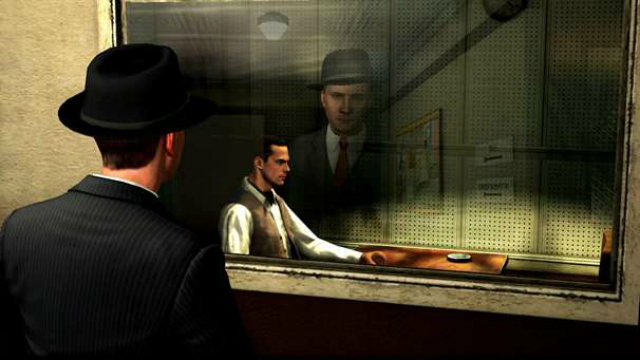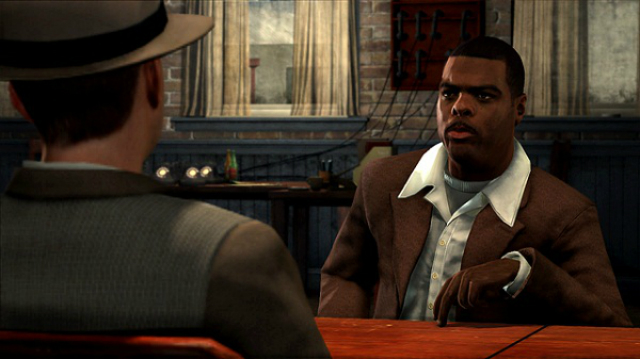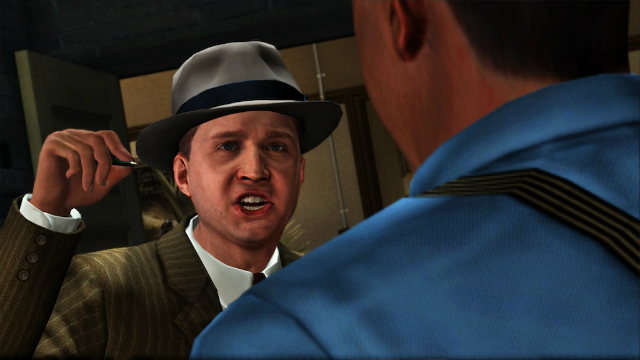The Story Mechanic Part Eleven: In The Interview Room
Recently, I’ve got really into murder. Not the physical act, you understand. I’m a gamer, my arms are way to weak to choke or club someone to death. Rather than take part, I have just been learning about it from a distance. It started with the BBC’s Sherlock, went via a number of popular crime books and detective novels, and then finished up with L.A. Noire. L.A. Noire is a fascinating game. Its combination of troubled development, one-off setting and engrossing ‘story first’ design make it a game that will continue to warrant analysis as the years pass.
The reason that it is particularly interesting for this column is that L.A. Noire is detective fiction in video game clothing. Detective stories work on a simple premise: You are reading a story with two distinct levels. The first level is that of a detective solving a crime, the hidden level is the crime itself. The story is set up as; crime, investigation of the crime, solving the puzzle (discovering the story of the crime) and catching the criminal. The reader follows the exploration, journeying with the detective through the world as they piece together what happened and why. I have said before in this column that game stories work best as journeys of discovery. The player should be able to search and learn the truth of a world, its quirks and its rules, rather than have have a story dictated to them like a film or a book. This is why, on the face of it, detective fiction and game narrative feel like natural bedfellows; they are both journeys of discovery. So why is it that so few developers have ever tackled detective fiction? Why is Team Bondi’s the exception and not the rule?

The answer, like in all true detective stories, lies in the interview room.
I love L.A. Noire. I love that it tries to be different. I love that it thinks it has style. I love the pomposity of its game design, the way the story is written, it either believes that it is too clever for you or that you’ll keep playing despite having deduced its twists and turns. You can see the challenges the developers faced in their solutions (I’ll come onto the three button questioning system soon). This is a game that has tried to do something new and, perhaps, surprisingly difficult. Mostly, I love how intertwined gameplay and story are; never more so than in the interview room.
In L.A. Noire, when the player is ready, they can interview suspects and witnesses. This involves selecting a topic to discuss, listening and watching the character answering the question, then deciding whether that character was telling the truth, whether their answer should be doubted, or whether you can prove that character was telling a lie. All conversations in the game break down in the same way, with a correct guess of truth/lie/doubt giving the player access to extra information. Success here, in gameplay terms, gives the player a deeper understanding of the story. You are literally playing the story, prizing the truth (or not) from characters lips, making the story happen rather than have it happen to you.

However, if it sounds like an artificial system, it is. Every conversation is structured in the same way so that interactions, despite the best efforts of the actors, start to feel formulaic after a while. The game’s systems start to reveal themselves, despite the developers best intentions. Any attempt to deviate from the established conversation format falls flat. In one early case, an interviewee snaps at the player “You just leave it to me and my husband to worry about”. How do you respond with truth, doubt or lie to that? There are times, when convinced at a characters guilt, that you want to be able to pursue a line of questioning and wear down a suspect, but it is not possible. The structure must be maintained. Think about the alternative; it is impossible to design a game where a player can have an open conversation with a character. You are playing a game, there must be a system and there must be rules.
This is why L.A. Noire was such a Marmite game upon its 2011 release and that is why more developers don’t tackle detective fiction, despite its superficially seductive game story qualities. At some stage, at some point, you have to tackle the challenge of creating believable, interesting characters that the player actually feels like they are interacting with. Detective fiction (particularly when you think of books like Sherlock Holmes) can have flat, uninteresting villains because they are nothing more than vessels for means, motive and opportunity. Villains certainly can be more interesting than that but, ultimately, they still perform the function of being a bloody blaggard if all they have is a reason to kill, a way of doing it and they take their chance.
That is not good enough in a game. That is why, I believe, L.A. Noire centred on its revolutionary facial technology. If the player didn’t feel like they were interacting with a real person, then the whole detective game narrative would never come together. Team Bondi knew it was vital to oppose the player with a convincing face across the digital table but, unfortunately for them, that is only the first step. It doesn’t take long until the player is working the system, not trying to interact with the other character. Rather than becoming immersed in a conversation and pursuing a line of questioning, being friendly to witnesses or testing the ego and insecurities of a hardened killer, the player is stuck within the confines of the system. Soon, the player finds themselves playing the percentages; checking for evidence of a lie, ruling that out and then doing what the instruction manual tells you; check whether they are looking straight at you, check for gulps, make your decision. The interviews are too limited, it feels too much like you are playing a game and the immersion just cannot hold.

That isn’t to say that the interview room is a failure. It successfully ties in other aspects of the game. Performance in the interview depends hugely on performance at the crime scene. Missed clues will likely be penalised whereas a thorough working of the scene will be rewarded with opportunities to catch the guilty or the dishonest in their fibs. L.A. Noire comes together beautifully when the player is playing well and getting it all right. When you read the face sitting across the metal table, sift the grains of truth from the muck and see for a fleeting second into the true story of the crime it is a magical sensation, gripping in a way that is unique to game narrative. The reward for playing hard and playing well is a glimmer of story, the real story that underpins all of detective fiction; that of the crime. The levelling rewards are trivial, the joy is to know that you got your man and that you know exactly what went on in that hotel room or back alley. It is a powerful moment for storytelling in gaming, I believe, because it shows not only what a strong motivational force story can be but also how effectively story can be made a vital gameplay mechanic, every clue found is a piece of the puzzle, a story element, that the player stitches together into a convincing whole.
So will we see more of it? How soon do I expect to be back on the street and working a crime scene.
Not very soon.
For all of L.A. Noire’s success I believe it highlights a huge challenge for storytellers in games; that of the convincing human interaction. Detective stories turn on the subtlety of these interactions and, as technology stands, the thrilling push and pull of an intense interview just seems worlds away.
When technology moves forward and it all comes together, I’ll be ready to get back into murder.




